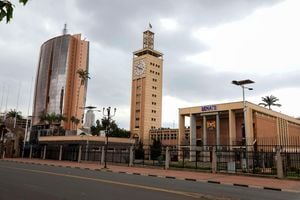Global and regional geostrategic implications of the Syrian crisis

Turkey's Foreign Minister Hakan Fidan meets with Syria's de facto leader Ahmed al-Sharaa, also known as Abu Mohammed al-Golani, in Damascus, Syria, December 22, 2024.
The seemingly sudden fall of the Bashar al-Assad’s authoritarian regime, two weeks ago, will go down as one of the most dramatic developments a region that is never short of surprises. Coming in the wake of Israel’s expanded war in the region, the collapse of the Syrian government, which was not foreseen even by Moscow and Tehran, the erstwhile strategic security benefactors of the Assad regime, raises the urgent geostrategic question of balance of power.
The Middle East has for decades been a high stakes geo-strategic region with its vast natural and economic resources, especially with the discovery, exploration and production of oil and gas. It has been a melting pot for international communication, transhumance and cultural exchange throughout history, connecting the Mediterranean and Red seas to the Indian Ocean. It is the home of the three Abrahamic faiths, Islam, Judaism and Christianity. Religion and oil are therefore, powerful centrifugal and centripetal factors in the political affairs of the Middle East, and significantly affect relations within and between states.
Syria has been a key player in the Middle East geopolitics since gaining its independence from the French Mandate in 1946. In 1958, as part of the Pan Arab movement the country joined Egypt to form the United Arab Republic until 1961 when it became an Independent state. With a tumultuous post-independence period marred with military coup’s, internal power struggles within the Baath party and civil strife, it became an authoritarian state under Hafez al Asaad. It also became a centre and conduit for the Iranian anti- Israel orchestrations, supplying groups such as Hamas, Hezbollah and Houthis with fighting hardware and providing succour to international terror groups including al Qaeda and ISIS.
Bashar al Assad came to power in 2000, following the death of his father Hafez, who had ruled Syria for 29 years. Like other Arab states, the Syrian regime was faced with the strong winds of so-called Arab Spring in 2011, which it survived, with the support of Russian air-power and Iran-backed Hezbollah-trained fighters. Then it became a theatre of warring factions with armed opposition separatist groups, largely Kurdish, the Syria Democratic Forces (SDF) supported by the US, and Islamic militant and extremist group, Al Qaida, which split and morphed into ISIS, each controlling some part of the country. International actors notably the Turks, the Russians, the Iranians and the US, have sway in different parts of the country.
Rebel movement campaign
However, its fast fall within a two-week onslaught by the rebel movement campaign, the Islamist militant group-Hayat Tahrir al-Sham ( HTS), led by Al Sharaa, a former Al Qaida/ ISIS – commander turned Syrian ‘liberator’, caught many geopolitical policy observers by surprise. The rebels quickly overran large swathes of territory all the way from their base in Idlib in the North west, through Allepo, the second largest Syrian city in the North, to Hama, to Homs in the central west, and finally closed in on Damascus without any resistance. Even Russia and Iran, appear to have been caught flatfooted, given that both had heavily invested in the security and protection of the Assad regime, offering strategic assistance and military cover.

People celebrate, after Syrian rebels announced that they have ousted President Bashar al-Assad, at Majdal Anjar in Bekaa, Lebanon, December 8, 2024.
And with the fall of the Assad regime, arguably the strongest link in the Iranian Axis of Resistance and the closest ally of Russia in the Middle East, a reconfiguration of balance of power, appears in the offing. Syrian has been hosting Russian military bases- an Air base in Hmeimim and a Naval one in Tartous, along its Mediterranean sea bed.
It is also noteworthy that the Assad regime has fallen at a time when the State of Israel, with the unwavering US military and intelligence support, is successfully dismantling the Iranian regional scheme of Axis of Resistance, which includes the Islamic militants in Syria itself, Hamas in Gaza, Hezbollah in Lebanon, Iraqi militias, and the Houthis in Yemen.
At the international level, the ousting of Assad and subsequent escape to Moscow on asylum, leaves Russia with a diplomatic shame on its face, an embarrassment and strategic failure of its Syria project. This foreign overture project was touted to have marked the resurgence of Russia in the global stage, a multipolar counter- balancer, and a key player in the international system reclaiming its lost glory after the ignominious defeat in the Cold war. And, with its 49-year-long lease of military bases in Syria, Russia began to project both air and sea power in the Middle East, the Mediterranean Sea, and across, in Africa.
With the vanquishing of the Assad family regime and takeover by militant Islamic group, the HTS, the credibility and image of Russia as a great power capable of sustaining a requisite level of support to prop up a political ally under siege, will be significantly eroded and perhaps damaged. Depending on whether Moscow will strike a cordial deal with the new administration in Damascus to respect the lease agreements for the military bases, and allow its continued presence, Russia’s projection of power in the Middle East, the Mediterranean and probably in Africa may suffer a setback, even if temporarily. The new administration’s foreign policy orientation may also be at variance with Moscow’s long-term strategic objectives, thereby holding the use of these bases, at least in the immediate term, in abeyance. It will therefore be interesting to see what the reaction from Moscow will be if the new administration turns its back against Russia and Iran.
Power balance equation
Under the circumstances, the great power balance equation would then favour the US, which has been omni present in the region with extensive footprints of military bases and assets, spread throughout the region, from Egypt in the west, to Israel, Saudi Arabia, Iraq and Qatar, among others.
With a weakened Russia, hitherto loud silence by the Arab League and other regional players, and non-active involvement of China in the regional affairs, the region’s geopolitics, will to a large extent be shaped by the US. The US has once more shown its global strategic outreach and power projection as a superpower, and it will through, and, with its regional allies such as Jordan, Saudi Arabia, Qatar and UAE continue to determine the regional security and political order, of the Middle East.
At the regional level, Israel, with the full support of the US, has emerged stronger and with the regional power- balance tilted in its favour. It has simultaneously dealt a decisive blow to its arch- nemesis, the Iranian regime in Tehran, demolished its Axis of Resistance, the Hamas in the Gaza Strip, the Hezbollah in Lebanon, the Iraqi Shia militias and the Houthi militia in Yemen.
Already, Israel is pounding military positions occupied and controlled by militant groups inside Syria which it deems to pose threats to its national security, territorial integrity and sovereignty. These targets include, but not limited to, airfields, military vehicles, anti- aircraft weapons, and arms production sites in Damascus, Homs, Tartous and Palmyra, as well as warehouses, Ammunition depots, sea to sea missiles.
The fear that these weapons could fall into the hands of extremists as well as access to the use of biological and chemical weapons, which Assad regime was known to have possessed and used against its own population, and the possibility of Syria slipping into chaos and factional groupings provide the impetus and rationale for these pre-emptive airstrikes.
However, new concerns are emerging about Israel’s uncensured air strikes and incursions into the Syrian territory beyond the demilitarised buffer zone, also known as the ‘Area of Separation’, in Syria, where UN peacekeepers are stationed. Although Israel has acknowledged that it has freely crossed over slightly over half- kilometre, into that area, it is raising alarm from the Turkish and other Arab states of possible Israel intention to extend its occupation further into the Syrian territory.
It must however be pointed out that, that area is still in dispute and ‘under Israel military occupation’ and not Israeli territory. It is also important to remember that, the Golan Heights which was captured by Israel from Syria in the 1967 Six-Day War is still regarded by the UNSC as ‘Occupied Territory’ (UNSC Resolution 497) despite the 1981 Israeli law claiming it as its territory and lobbying international community to recognise it as such.
Thirdly, within the region, Iran has suffered the most. Its regional power status has been challenged and its proxy networks severely devasted. Faced with internal disloyalty, and with its Axis of Resistance dismally demolished— save only for the Houthi rebels which still conduct anti- Israel military operations in the Mediterranean Sea.
Deserted power
Analysts point to only two mutually exclusive possible pathways for Iran. One, with the Axis of Resistance network nearly collapsed, and the Assad regime having deserted power and authority, it is for Iran to recant its hard, non-recognition stance on Israel, and especially, to grab the earliest opportunity to engage with the in-coming Trump administration, in order to re-establish friendly diplomatic relations with the US, have the economic and other sanctions removed, and spur its struggling economy. And two, to follow the path of self-gratification and try to resuscitate and revamp its badly broken and damaged network of regional militias, the Axis of Resistance, including to stubbornly go ahead and develop its highly enriched uranium into a nuclear weapon, with obvious corresponding consequences.
Fourthly, Turkey has been actively involved in Syria for some time now since 2016 when it invaded large areas of northern Syria occupied by the Kurdish population. It has continued to conduct airstrikes against the Kurds in Northern Syria. The Turkish -backed Syria National Army (SNA) has been hitting at the US-backed Syrian Democratic Forces (SDF) which had played a major role in defeating ISIS in Syria. And so a geostrategic conundrum is emerging out of the fall of the Assad regime in which Turkey and Israel will likely intensify their sabre-rattling over the control of parts of the Syrian territory. The implication of this is that until and unless a credible, effective and recognised administration is established in Damascus, the two regional powers left standing, Israel and Turkey, will be directly facing off each other on the Syrian territory.
Finally, there is fear and concern that although HTS seemed to have broken ranks with ISIS and appearing not interested in turning its back, the remnants of ISIS might be regrouping to take advantage of the power vacuum in the large uncontrolled spaces in Syria. Its important to remember that HTS, and its leader Al Sharaa, are designated in the US Terror list and wanted. If the International community under the purview of the UN and the Arab League does not move with speed to help in the establishment of a new administration, support it settle down and take charge and be in control, then the possibility remains high of Daesh/ ISIS or a new Jihadist group seizing the moment to be the net-winner out of this whole situation.
Mr Ogego is a former Kenyan Ambassador to the United States and is currently a tutorial fellow and PhD Research candidate in the Department of Diplomacy and International Studies (IDDIS) at the University of Nairobi





